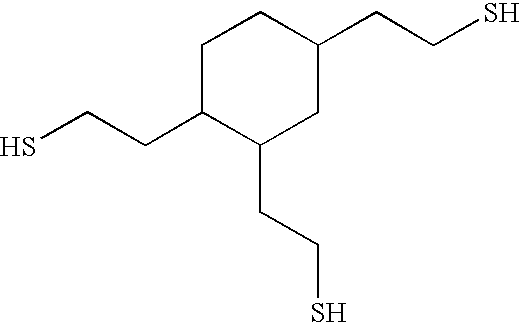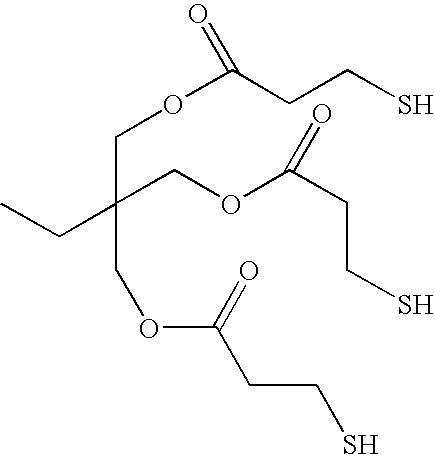Sulfur-containing cycloaliphatic compound, filled sulfur-vulcanizable elastomer composition containing sulfur-containing cycloaliphatic compound and articles fabricated therefrom
a technology of cycloaliphatic compound and composition, which is applied in the direction of silicon organic compound, group 4/14 element organic compound, tubular article, etc., can solve the problems of lack of flexibility and inability to achieve satisfactory vulcanizates exhibiting wear and other problems, to achieve the effect of high adsorption or absorption capacity and high surface area
- Summary
- Abstract
- Description
- Claims
- Application Information
AI Technical Summary
Benefits of technology
Problems solved by technology
Method used
Image
Examples
example 1
[0094]This example illustrates the preparation of thioacetic acid S-{2-[3,4-bis-(2-acetylsulfanyl-ethyl)-cyclohexyl]-ethyl}ester whose structure is:
[0095]Thioacetic acid (1,974 grams, 25.9 mol.) was charged into a 5-liter round bottom flask. Air was bubbled into the thioacetic acid using a fritted tube. 1,2,4-Trivinylcyclohexane (1,303 grams, 8.0 mol.) was added dropwise using an addition funnel over a period of 2.5 hours. An exotherm was observed. The temperature was maintained at 32° C. using an ice bath. After 4 hours, the ice bath was removed and the reaction mixture was stirred for an additional 16 hours while air was being bubbled through the reaction mixture. The excess thioacetic acid was removed by stripping the solution under vacuum at approximately 100° C. The yield was quantitative, producing 3,137 grams of product. GC analysis confirmed that the reaction was complete.
example 2
[0096]This example illustrates the preparation of 2-[3,4-bis-(2-mercapto-ethyl)-cyclohexyl]-ethanethiol whose structure is:
[0097]The acyl group was removed by the transesterification reaction. The thioacetic acid S-{2-[3,4-bis-(2-acetylsulfanyl-ethyl)-cyclohexyl]-ethyl}ester (3,090 grams, 7.9 mol.), that was prepared in Example 1, was charged to a 5-liter round bottom flask. Ethanol (1,070 grams, 23.3 mol.) and sodium ethoxide (68.6 grams) was added with stirring. The mixture was heated to refluxing conditions for 4 hours and the ethyl acetate that formed was removed by distillation at atmospheric pressure. An additional amount of ethanol (672 grams, 15.6 mol.) was added and the mixture was refluxed overnight. The ethanol and ethyl acetate were removed by distillation. The addition of ethanol and removal of ethanol and ethyl acetate was repeated two more times. The 2-[3,4-bis-(2-mercapto-ethyl)-cyclohexyl]-ethanethiol (1,884 grams) was a pale yellow hazy liquid.
example 3
[0098]This example illustrates the preparation of an isomeric mixture containing 84.82 weight percent thioacetic acid S-{2-[3,4-bis-(2-acetylsulfanyl-ethyl)-cyclohexyl]-ethyl}ester.
[0099]A mixture of stereochemical isomers of 1,2,4-trivinylcyclohexane was prepared by fractional distillation. The distillation unit consisted of a 5-liter round bottom flask, a strip silvered column (inner diameter of 51 mm, height of 1,470 mm) equipped with stainless steel flat mesh screen supporting a 316 stainless steel Propac 0.16 mesh ball, size rating 0.16 inch packing material, and a reflux condenser. Trivinylcyclohexane (4,150 grams) and 4-tert-butylcatechol (4.5 grams) were charged to the flask. The pressure was reduced to within the range of 6.5 torr to 7.3 torr and the temperature to within the range of 90.0° C. to 90.8° C. The boiling rate was maintain at 6 drops per second. The distillated was collected and analyzed by gas chromatography. The gas chromatography column and conditions were a ...
PUM
| Property | Measurement | Unit |
|---|---|---|
| Fraction | aaaaa | aaaaa |
| Fraction | aaaaa | aaaaa |
| Percent by mass | aaaaa | aaaaa |
Abstract
Description
Claims
Application Information
 Login to View More
Login to View More - R&D
- Intellectual Property
- Life Sciences
- Materials
- Tech Scout
- Unparalleled Data Quality
- Higher Quality Content
- 60% Fewer Hallucinations
Browse by: Latest US Patents, China's latest patents, Technical Efficacy Thesaurus, Application Domain, Technology Topic, Popular Technical Reports.
© 2025 PatSnap. All rights reserved.Legal|Privacy policy|Modern Slavery Act Transparency Statement|Sitemap|About US| Contact US: help@patsnap.com



